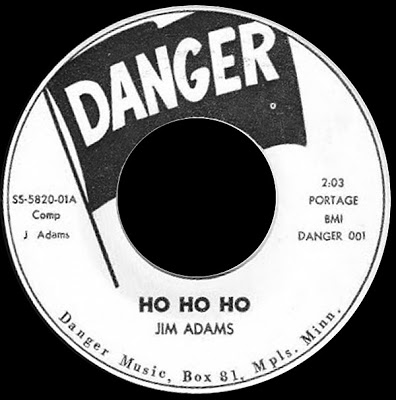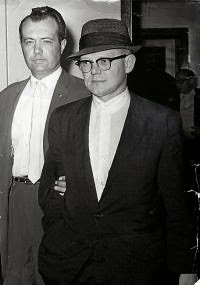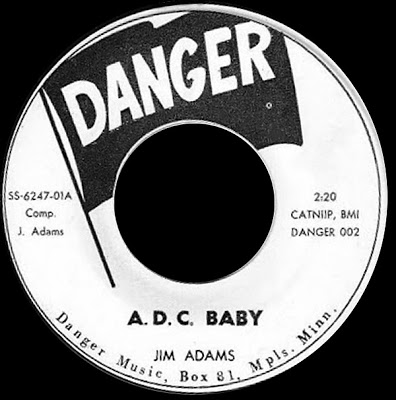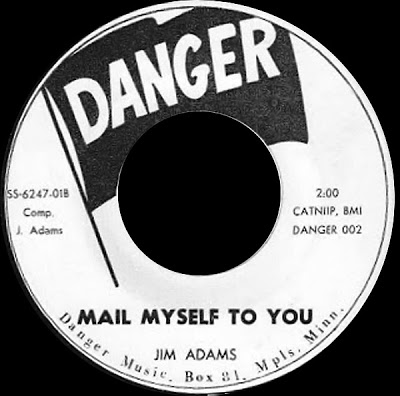I have two records by Jim Adams and I love all four sides. Let me share them with you!
Despite my efforts to track him down, Jim Adams remains a total mystery to me. I can only assume from the subject matter and his accent that he comes from Minnesota, or maybe North Dakota. I’ve heard that he relocated to Los Angeles, but after that the trail goes cold. My guess is that these two records were published in 1963, or perhaps slightly later. These are the only two records I’ve ever seen on the Danger label, so I’m pretty sure this was self-published. If you have any more information about these records or Jim Adams, I’d love to hear from you. I have lots of reason to believe that this guy is NOT the reporter for the Minneapolis StarTribute by the same name, mainly because he would have been nine years old when these records were made.
These are all crazy and fun songs! Let’s start with his first release, and today’s New Oldie. This song made me laugh out loud when I heard it for the first time. Don’t ask me why because I can’t tell you. I just think it’s a clever play on words.
Here’s Ho Ho Ho by Jim Adams on Danger 001 from 1963:
The flip side of this single is much more interesting. Supposedly, shortly after it was released, it went to #1 in Metered Jukebox Play in the Midwest area, which covers five states including Minnesota. This is a song about a family man who allegedly hired someone to kill his 34-year-old wife and mother of his four children, Carol Thompson. The man’s name was T. Eugene “Cotton” Thompson, a 35-year-old lawyer who lived, at the time, on Hillcrest Avenue in Highland Park, a suburb of St. Paul, Minnesota.
Cotton, who was at work at his office at the time of the attack on his wife, claimed to have called his home at 8:25am to confirm some evening plans with his wife. But investigators don’t believe that was the real reason for the call. It seems that Cotton had taken out several life insurance policies on his wife, with death benefits totaling around a million dollars. He was also seeing a girlfriend named Jacqueline Olesen at the time. The death of his wife may have been part of a plan to eliminate the wife from his little love triangle, thus freeing him to marry his mistress. Of course, there’s always the possibility that the mistress herself had something to do with the crime!
You can read an in-depth accounting of the murder in a book called Dial M: The Murder of Carol Thompson by William Swanson.
The contract killer really botched the job. Carol was beaten and fatally stabbed in the neck in the bathroom of her home on the early Wednesday morning of 6 March 1963. But, before she died, she managed to escape and make her way out of the home while her attacker fled the scene.
Carol’s murderer was quickly apprehended and later confessed to the crime, implicating Cotton and another man in an elaborate conspiracy. According to testimony, Cotton had actually hired a former prize fighter and legal client named Norman Mastrian to murder his wife. The initial offer was $4000 if it looked like an accident, and $2000 if it did not.
Cotton would make sure the family dog was removed from the house. Norman was instructed to enter the home before dawn through a side door that Cotton would leave unlocked, then hide in the basement until the children were all off to school. This also allowed Cotton to have time to get to the office and establish his alibi. Cotton was to call his home at exactly 8:25am. He’d moved a portable phone to a jack next to the basement door. The plan was for Cotton’s call to draw his wife to that phone where she could be attacked through the basement door while distracted by his call. Norman was supposed to hit her with a rubber hose, then drag her into the bathtub to make it look like an accidental drowning. He was to leave her lying in the water, chain the door, then make his way out of the house.
But, for whatever reason, Norman never actually went through with the murder. He sub-contracted the job to a man named Dick “W.C.” Anderson. Dick wasn’t sure it could make it look like an accident and insisted on taking along a gun, just in case. The two agreed to a flat fee of $3000 and Norman provided Dick with rough floor plan of the house and a Luger to carry with him as a back-up weapon. It’s not clear if Cotton knew about this change in plans ahead of time, but there’s a good chance he did not.
Just before daybreak, Dick parked his car a block away. He entered the house through the unlocked side door. It was dark, so he had to use a small flashlight to find his way to the basement door. The steps creaked as he went down them and found a place to hide in a storage room. He waited there, listening to the sounds of breakfast being prepared and eaten, after which the kids left for school. Cotton told his wife he didn’t want any more coffee, then left for work himself, taking his son with him to drop him off at school on the way to the office. From his basement hiding place, Dick finally heard the sound of Carol quietly climbing the stairs to the second floor.
The contract killer waited for the phone to ring at 8:25. Cotton may have been a bit late, because the phone actually rang at 8:28, according to Dick’s watch. After several rings, he heard Carol coming down the stairs, then heard her voice as she answered the phone. He abandoned the plan to attack her during that call because he was concerned that she would be alerted to his approach by the creaking stairs. Instead, he waited for her to return to the second floor. He put on surgical gloves, inserted one shell into the chamber of the Luger, and then crept up the stairs, using the edges of each step to avoid any noise.
He searched the first floor to make absolutely sure nobody else was home. As he made his way to the master bedroom on the second floor, he heard a radio playing. When he opened the door, he saw Carol sitting on the bed, wearing her reading glasses, and reading a magazine with the light from a bedside lamp. When Carol saw him, and his gun, he told her to turn her head so she couldn’t see him. He told her to relax and assured her that he had no intention of hurting her. He said that he only wanted some money. She told him that he could find money in the dresser and he asked her to lie face down on the bed.
Dick shoved the gun into the right pocket of his coat and took out the rubber hose. He hit her with it as hard as he could across the base of her skull. He laid the hose on the bed, ripped back the covers, and tore off her nightgown. He carried the hose and nightgown with her into the bathroom. He sat her body in the bathtub and filled it partially with water. Pushing on her chest, he held her head under water. At this point, Carol regained consciousness and started fighting him. He had trouble holding on to her because the surgical gloves were wet and slippery.
Dick fumbled for the gun in his coat pocket while Carol began running away. She made it down the hallway back to the master bedroom. He grabbed a pillow from a one of the other bedrooms and flipped off the safety on his gun. Carol was in a panic, quickly pulling on a blue bathrobe. He got right up close to her and pointed the gun directly at her. She pleaded with Dick not to shoot her. She told him that her husband was a criminal lawyer and she’d make sure he would protect him from the police. He pulled the trigger — but nothing happened.
Dick dropped the pillow and started punching the gun with his left hand. This delay gave Carol an opportunity to slip past her attacker and run away. Dick quickly turned and hit her with the butt of his gun. Carol fell, then got back on her feet. Dick tried to reload, allowing Carol to get past him again and start running away.
The two ran down the hallway, then down the stairs, just a few feet away from each other. Carol made it to the front door, but the door chain kept her from getting it open. That small delay allowed Dick to catch up with her and he began hitting her repeatedly with the butt of the gun. She pulled off her diamond ring and offered it to him. He took it and dropped it to the floor, hitting her again and again with the gun. She fell to her knees crying, “God help me!”
Even after she fell to the floor, Dick continued beating her with the gun. He hit her so hard that the plastic grips on the handle of his pistol were shattered and the trigger guard was bent. He hit her at least 25 times while she continued to plead with him to stop. She finally lost consciousness once more.
At this point, Dick ran to the kitchen and searched several drawers for a butcher knife. He decided instead to grab a paring knife. He took that back to Carol’s body and rammed it into her throat three times, breaking the blade off on the third blow. He left the blade sticking out of her neck.
Dick assumed that Carol was either already dead, or quickly dying, and didn’t think she could get back up. So, he went back to the master bedroom. He had intended to clean up the evidence of deliberate murder, then try to make it look like a robbery gone wrong. He dumped out drawers and scattered things around. He then went into the bathroom to wash off the blood. He heard the door slam!
Dick ran downstairs to find Carol’s body gone. In a panic now, he left the house and walked slowly toward his car and drove home. With her blue bathrobe barely covering her naked body, Carol made it to the nearby home of Harry Nelson and his wife a couple doors down the street. Mrs. Nelson was home at the time, watching the news. When she opened the door, she could not recognize Carol at first through all the blood. Carol clutched her neck around the protruding blade and struggled to talk. Mrs. Nelson covered Carol with a blanket.
Meanwhile, another neighbor from across the street, Mrs. Fritz Pearson, saw Carol through her window and called police. Carol was taken to Ancker Hospital and Cotton was contacted at his office to alert him to the incident. Carol went into shock and was pronounced dead at 12:58pm.
The crime was heavily publicized and became known as the “Murder of the Century” in Minnesota. The 1996 movie Fargo starring William H Macy and Steve Buscemi was very loosely based on, or at least inspired by, the murder of Carol Thompson.
T. Eugene Thompson denied having anything to do with the crime, and still maintains his innocence to this day. Despite his denials, a jury convicted him in December 1963 and he spent the next 20 years in jail.
Cotton was released on parole in 1983. To the best of my knowledge, he’s 85-years-old now and still living in the Twin Cities. His son Jeff, who was 13 at the time of the murder, became an attorney and ended up being a judge in Winona, Minnesota. The couple also had three daughters, all younger than Jeff, with the youngest being only 6 years-old at the time. Despite everything that happened, Eugene’s children still maintain a cordial relationship with their father.
Here’s Ballad Of T Eugene by Jim Adams on Danger 001 from 1963:
Jim Adams made a follow-up record that’s not what you’d call “politically correct.” This one is about a man who has a girlfriend who is living off of a government program known as “A.D.C.,” which stood for Aid to Dependent Children. This government program authorized case workers, supervisors and administrators with the discretion to determine who would receive this financial aid.
This program got started during the term of President Franklin Delano Roosevelt (FDR) as part of America’s push toward Socialism in a set of new programs collectively known as The New Deal, and included as part of the Social Security Act in 1935. It was initially available exclusively to poor white single mothers. Efforts of the Civil Rights Movement by the National Welfare Rights Organization helped extend the program to black women in the 1960’s, and the name was also changed to Aid to Families with Dependent Children. In 1996, the program was replaced by the Temporary Assistance for Needy Families program.
There were many critics of this plan over the years, and you’ll find all kinds of strange “facts” about it, most of which are only partially based in the truth. Let me just try to cover some of these concerns. For starters, there seems to be ample evidence to suggest that government aid programs, like this one, tend to cause an increase in the number of people who become dependent on government for their survival. Instead of working toward self-sufficiency and climbing out of poverty, these programs allow them to avoid working and, thus, remain in poverty for the remainder of their lives. There’s also an argument that parents who become dependent on the government become role models for their children, creating a growing dependency class of people who end up living their entire lives on welfare. Many people believed the program encouraged, and, in fact, rewarded women for having more children, and having as many of them as possible out of wedlock. There were also concerns that men would take advantage of the program by stealing money from mothers who received benefits from the program. This, in fact, is the subject of this song.
Finally, here’s the flip side of Jim’s second record, another silly song that talks about a man who drops himself in the U. S. Mail.






Don't you have a link or something so we can hear the 4 songs by Jim Adams?
Hi Chet! Unfortunately, you can only play them on a computer browser. The embedded player uses Flash, which is not compatible with Apple mobile devices, like the iPhone and iPad. If you load the page on a computer you will see the players.